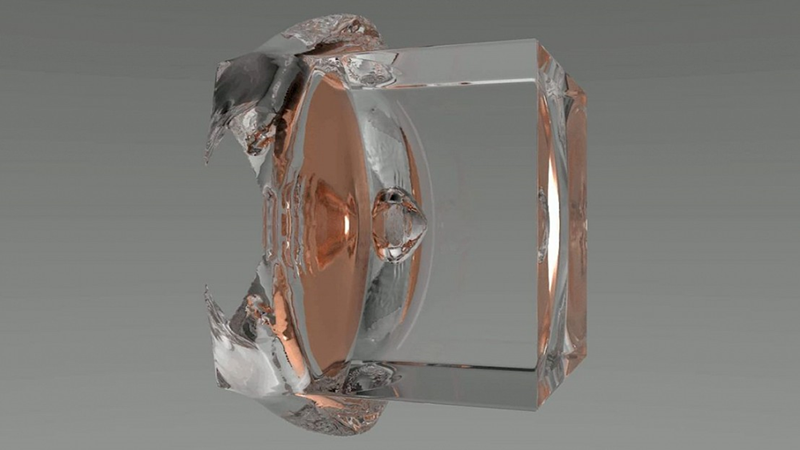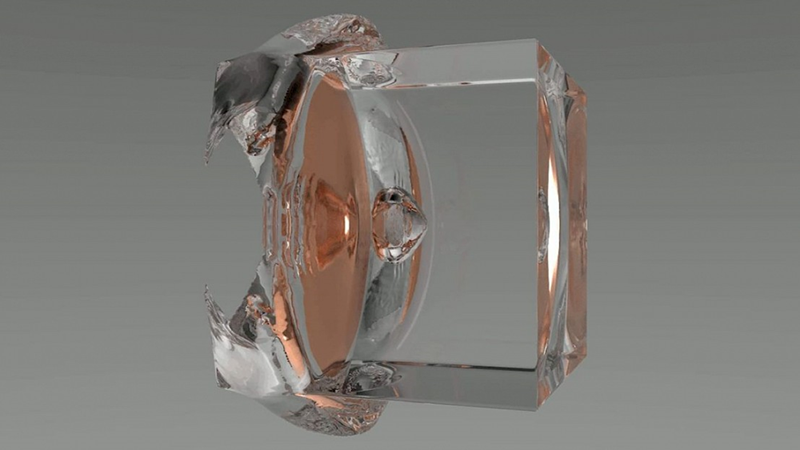Inertial-Confinement Fusion without Lasers
Researchers have repeatedly shown that laser light impinging on a hydrogen-filled capsule can ignite nuclear-fusion reactions that produce more energy than that delivered by the laser beams (See Viewpoint: Nuclear-Fusion Reaction Beats Breakeven). These demonstrations of so-called inertial-confinement fusion by the National Ignition Facility (NIF) have inspired a number of followers. Start-up companies in the US, Europe, and Asia are exploring power-plant designs that might one day deliver electrons to the grid. One of these companies, First Light Fusion in Oxford, UK, has a radical idea: inertial-confinement fusion without lasers. The fusion-producing mechanism would instead be a bullet-like collision between a coin-shaped projectile and a specially packaged hydrogen-filled capsule. The First Light team has recently recorded fusion reactions with their setup, and they are now constructing a demonstrator that they hope will show a self-sustaining burn, or “ignition,” by the end of the decade.
There are many approaches to nuclear-fusion reactors, but one of the main strategies is the inertial-confinement fusion pursued by the NIF. The basic elements of inertial confinement are a pea-sized fuel capsule (typically a mixture of the hydrogen isotopes, deuterium and tritium) and a means for rapidly compressing and heating this fuel. At the NIF, the compression comes from 192 high-energy laser beams that target the fuel from different directions. But the laser light does not directly strike the capsule. Instead, it heats up a metallic container to several million degrees, generating x rays that irradiate the capsule and induce the fusion reaction.
After years of setbacks, the NIF recently began seeing higher and higher yields from their laser shots. In December 2022, researchers recorded a shot that produced 3.15 megajoules (MJ) of energy from a laser input of 2.05 MJ, implying a gain of 1.5 (see Research News: Gaining Ground in Nuclear Fusion). This milestone demonstrated that a fusion burn was possible with the inertial-confinement approach. “I think inertial fusion is experiencing a huge upsurge in interest following the NIF result,” says Nick Hawker, First Light’s cofounder and CEO. That upsurge is directed toward developing commercial power plants running on nuclear fusion—which promises to be a cleaner, more sustainable alternative to nuclear fission.
The field of inertial confinement fusion has been transformed over the past few years, says Robbie Scott, a fusion theorist from Rutherford Appleton Laboratory in the UK. “Historically, most of the effort has gone into the science, rather than developing the engineering required for energy production,” Scott says. But now there is a lot of talk about how to turn the science of the NIF into a working power plant. “We’ve proven the fundamental physics works, but there’s a lot to be done in terms of optimization of the technology,” he says.
However, the NIF was not designed to generate electricity. The NIF laser requires about 400 MJ of electricity for each shot, so the net gain is less than 1%. Even if more energy could be produced than put in, there’s no way at the moment to recover that output energy and turn it into electricity. Moreover, the NIF experiment can only manage about one shot per day, whereas a working plant would need a source able to fire about one shot per second. Thus, there are formidable challenges that stand in the way of fusion-based power plants.
But those challenges are not scaring away entrepreneurs. First Light started in 2011 when the fusion-based private sector counted nine companies, according to the Fusion Industry Association, which promotes commercial fusion. Today, two dozen companies are pursuing a wide gamut of strategies that include inertial confinement and other fusion methods. “The commercial landscape is absolutely wide open,” Hawker says.
Most of the inertial confinement start-ups are following in the NIF’s footsteps, but with a modified footprint. “The NIF’s demonstration of ignition was the last bit of unknown physics,” says Hugo Doyle, First Light’s head of experimental physics. “Everything else is just scaling it up.” California-based Longview Fusion Energy Systems plans to build a NIF-like reactor, but with a more efficient laser and a shot repetition rate of several hundred times per minute. Focused Energy in Texas has a two-pulse approach for imploding and igniting the fuel, while Xcimer Energy in California plans to replace the NIF’s solid-state laser with a gas-based laser that is expected to deliver more than 10 MJ of energy per shot. Two other companies, Marvel Fusion in Germany and HB11 in Australia, will try to replace the pure hydrogen fuel with one containing the element boron.
“Having various options at this stage of the game is good,” says Michael Campbell, a former director of the Laboratory for Laser Energetics at the University of Rochester, New York. He thinks the fusion community should take advantage of this diversity and closely consider the advantages and challenges of each option. Doyle agrees. “A few years ago, people would ask, When will fusion show gain?” he says. “The question now is, Will a power plant be economic?” He thinks that start-ups like First Light will compete with each other to see who can produce electricity from fusion at the lowest cost.
First Light’s approach is to abandon lasers entirely. In what sounds like a throwback to centuries-old artillery design, the company’s researchers fire a metallic projectile at a NIF-like fuel capsule embedded in a cube. The key technology lies in that cube, which the team calls the amplifier. The amplifier contains several small spherical cavities that channel the impact energy from the projectile onto the fuel capsule. “It’s like a lens for focusing light,” Hawker says. “But it’s for focusing shock waves.” This focusing can convert a projectile’s speed of several tens of kilometers per second—equivalent to an impact pressure of about 100 gigapascals—into a capsule implosion speed of several hundreds of kilometers per second (equivalent to a fuel pressure of 10–100 terapascals), enough to drive a fusion reaction.
This “projectile fusion” is a significant step away from the path that the NIF is treading, but it could offer some advantages in simplicity. “They’re pursuing a novel approach to inertial fusion, which, if it works, could be significantly cheaper than laser-based approaches,” Scott says. Campbell also thinks that First Light has an interesting approach. “They have a good scientific and engineering team, so I’m impressed by that.” He says he can’t comment on the target design since most of the details aren’t publicly available, but he has seen some of their future plant designs. “They have some innovative technology that is worth looking at,” he says.
In a trial experiment in November 2021, the company reported that they had generated fusion using a high-powered gas gun to accelerate a projectile at a fuel target. The evidence of fusion was the detection of about 50 neutrons from the reaction center—a small yield—but in line with their models’ predictions. With funding of about $100 million (mostly from private investors), the company is now building a scaled-up version of their experiment that will fire projectiles at 60 kilometers per second using an electromagnetic pulse generator. The goal is to demonstrate ignition, a feat that would correspond to a yield of 1016 neutrons. “It sounds like an enormous distance to go,” Hawker says. But he says that fusion is very nonlinear, meaning a small improvement in the design can have a large impact on the output. “I feel very comfortable with the goals of our ignition demonstrator,” he says.
The demonstrator is expected to be completed in the later part of this decade. The company has also begun to imagine the next step: a commercial reactor. To protect sensitive equipment from the intense energy release from fusion, the plan involves dropping the fuel target (the capsule and its amplifier) into a chamber and firing the projectile from above. The impact would occur in the center of the chamber, where a blanket of liquid lithium would absorb the energy of the reaction and transfer it as heat to a water-filled boiler for the production of electricity. The lithium blanket would also allow the recovery, or “breeding,” of tritium fuel, as high-energy neutrons from the fusion reactions can interact with lithium to produce tritium plus helium.
Other fusion-reactor designs have a similar setup, with protective blankets and heat exchangers. Doyle says the difference between designs are sometimes subtle, but they can have an impact on tritium breeding and other important issues such as managing radioactive waste. Unlike fission, fusion is not expected to produce any high-level radioactive waste—which remains radioactive for tens of thousands of years and poses enormous storage challenges. But some of the neutrons emitted by fusion reactions can strike surrounding structures, such as metallic walls, causing nuclear transformations in the materials. Such “activated” materials could constitute intermediate-level waste that would need to be properly disposed of. Having a lower waste profile could be a strong selling point for future fusion-power-plant designs, Doyle says.
First Light is projecting to build a pilot plant in the mid-2030s. Other inertial-confinement companies have set similar timelines. Scott and Campbell are less optimistic: they both imagine the first working reactors might not be ready until the 2040s. “I have a joke,” Campbell says. “I say my 28-year-old son will likely see commercial fusion power in his lifetime. And thanks to improvements in life expectancy, that could either be when he’s 50 or 120.”
–Michael Schirber
Michael Schirber is a Corresponding Editor for Physics Magazine based in Lyon, France.





